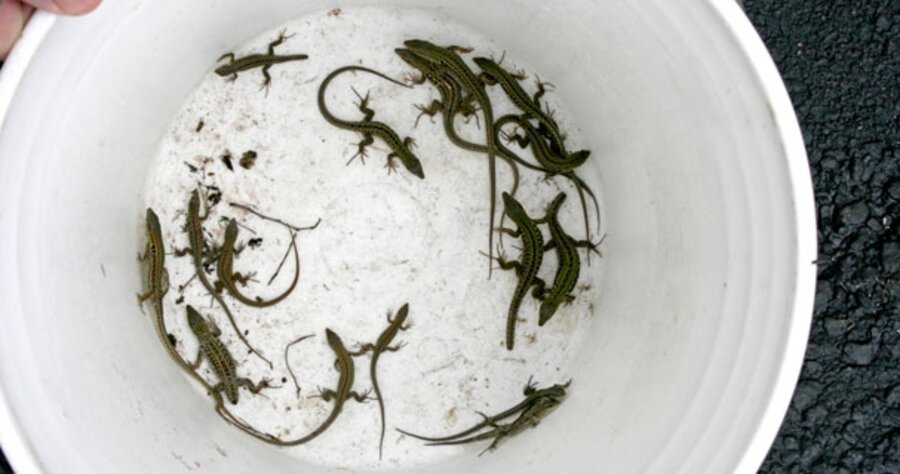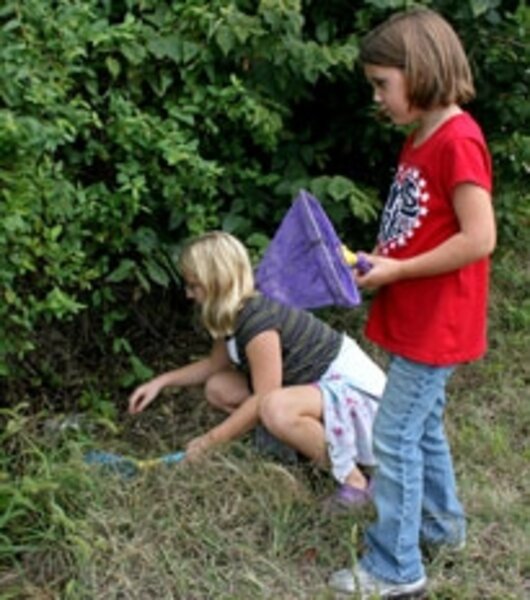‘Running of the Lizards’ yields a slithery quarry
Loading...
| Topeka, Kan.
Keith Arkenberg, a college senior, has honed his own technique. When trying to catch a lizard, he doesn’t sneak up behind it or flash a butterfly net. He just gets down in front of it, stares it in the eye, and snatches it before it darts off.
Which is why Arkenberg, a tall, slender biology major with a brown ponytail, is hunched down in an alley near an auto-parts store here in Topeka, Kan., across from Dimple Donuts. He is stalking the elusive Italian wall lizard. His technique proves triumphant: Over the course of two hours on a sun-dappled day, he snares four of the slithery creatures.
“I used to catch a lot of frogs to feed my snakes when I was younger,” says Arkenberg. “It’s just a matter of getting down in front of them and grabbing them before they take off.”
The point, in the end, may not be how he actually catches them. It may be why anyone who is pursuing a college degree, and thus presumably in his right mind, would be chasing lizards on an afternoon in Topeka, Kan., anyway. In fact, some 30 adults and children are gathered to hunt the four-inch reptiles. They are part of an annual ritual to collect Italian wall lizards in the name of science and a little fun.
Pamplona, Spain, has its running of the bulls. Anchorage, Ala., its running of the reindeer. San Juan Capistrano, Calif., its swallows. Here in Topeka, it’s the Running of the Lizards. For 11 years, college students and a few local residents have been trying to collect and count as many lizards as they can as part of an informal census of the reptiles and to engage in the outdoors.
It isn’t a big civic event, really. It’s more the hobby of Joe Collins, a herpetologist for the Kansas biological survey at the University of Kansas and a part-time professor of herpetology at Washburn University in Topeka. It may take a herpetology degree, in fact, to fully appreciate the joys of scampering after lizards in alleyways – and to actually ambush one.
“Those who have done it before know what has to be done to catch these lizards,” Collins told the gathered crowd before the hunt. “Those who haven’t learn just how fast little lizards can be. They really like to hide under the air conditioners at Kentucky Fried Chicken. It’s their natural habitat.”
•••
The Italians apparently brought the wall lizard up right: It is a highly adaptable creature cloaked in a skin of bright colors suitable for a Milan fashion runway.
The reptiles have Kelly green backs mottled with black and brown pattens. Turquoise spots dimple their sides.
The size of a large Tootsie Roll, the Italian wall lizard is found in various parts of Europe and is the most abundant lizard species in southern Italy. Its presence in Topeka, one of the few American cities with a sizeable colony, is rooted in a bit of serendipity and mystery.
Local experts trace its origins here back to a biological supply house, Quivera Specialities, that was operated by Charles Burt on SW 21st Street some 40 years ago. Professor Burt – or so he was known in the neighborhood – imported a wide variety of reptiles, birds, insects, and other species and sold them to researchers and universities all over the country.
Perhaps it was inevitable, but some of the animals escaped, as captive animals are wont to do. Keith Coleman, who has attended many lizard runs over the years, grew up in a house next door to the supply store. He remembers occasionally seeing exotic birds and snakes and other non-native species in the neighborhood.
Legend has it that when Mr. Burt died, sometime in the 1960s, his widow let all the animals go. Most perished in the cold winter, but since southern Italy is roughly the same latitude as Kansas, the lizards survived, even thrived.
Now, 40 years later, it’s estimated that tens of thousands of wall lizards, also know as ruin lizards, have taken up residence in the southern section of the state’s capital city.
As it turns out, two different lizards have adapted to urban Topeka, the other one being the Western green lacerta, which is all green and much larger then the Italian wall lizard. It is also far more scarce. The green lacerta are more arboreal, living primarily in bushes and low trees and are rarely seen and even more rarely caught.
“If you get one of those, that’s extra special,” Collins tells the group, then adds with a audible wink, “If you’re in my class, that’s a really good grade.”
Many of the gathered reptile hunters are, in fact, Collins’s students. Others include former students, a coterie of amateur herpetologists, and interested citizens, among them lots of children, who seem to view the event as a cross between an Easter egg hunt and a reptilian petting zoo.
The primary objective of the event is pure enjoyment. But it also serves to give the students in Collins’s class a tuneup before he takes them out on a longer field trip into the woods, where they’ll have to wear boots and gloves, grapple with chiggers, and forgo ready access to doughnuts, fast food, and, if possible for this generation, Facebook.
Collins himself looks like a good fit to be a Marlin Perkins of the lizard world. He has a bald pate and a bushy white beard. He looks out from behind wire-rim glasses and smiles readily.
•••
Collins starts the event in a parking lot at SW 21st Street and Gage Boulevard. It is a warm day with peekaboo sunshine – good but not perfect for catching lizards, which come out in the sun and heat. Wearing jeans and sturdy cowboy boots, Collins encourages the crowd to work in groups to better corner the wily creatures.
Then he leads them, Moses-like, across four lanes of traffic to the rear parking lots of several commercial buildings – an auto-parts store, a dry cleaner, a gas station, an empty video game store. The group fans out over a two-block area, hunting in weeds and tall grass, under rocks and debris, behind dumpsters.
Three sophomore biology majors work together and manage to catch four among them. Seventh-grader Jenna Brunkow has a good day, too, corralling two in her first event. Fourth-grader Shania Edmonds’s catch is truly a joint effort: A lizard jumps on her back and one of the adults puts it in her bucket.
Others aren’t so fortunate. Young Michael Cantrell decrees the whole thing “boring,” as he and his brother go home with only a single lizard – and that one caught by someone else. But Jacob Van Hoye, 12, is so excited by his multiple lizard outing, he vows to return the next day after school.
(My own scientific conclusion, gleaned from two hours of close study and observation, echoes the common refrain about fishing: One’s enjoyment of the Running of the Lizards is directly proportional to number of lizards one catches.)
By 2 p.m., the lizard chasing is winding down. The lizard hunters head back across the street to their cars, many of them carrying jars, small plastic aquariums, and other containers holding their quarry. Collins estimates the participants caught more than 40 lizards and spotted at least 100. He plans to take a tiny blood sample from many of the 20 or so he caught and then release them into the “wilds” of urban Topeka.
“Everyone had fun,” he says of the day. “A lot of people got lizards to take home. The sale of crickets will go up. Life is good.”






